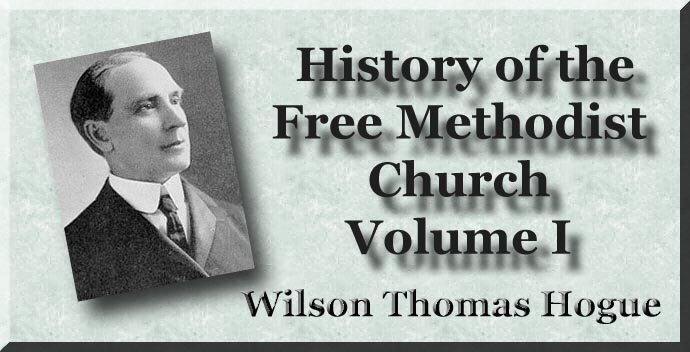
History of the Free Methodist Church of North America
Volume I
By Wilson T. Hogue
Chapter 4
SPIRITUAL DECLINE OF AMERICAN METHODISM—SECRET SOCIETIES
Confirmatory of the foregoing statement of the case
is the following, from a pamphlet written and published by the Rev. C. D.
Burlingham, of the Genesee conference, in 1860, entitled: “An Outline History of
the Genesee Conference Difficulties”:
There were many in the Conference who, with prophetic vision, foresaw the evil consequences likely to arise from the alliance of the Church through her ministers with the system of oath-bound secrecy, and who consequently strove earnestly to resist the encroachments of the Lodge upon the Church. They knew full well that, in the days of her greater purity and power, Methodism could not have been betrayed into such an enervating and corrupting amalgamation with the world. As simpleminded Christians, who had been taught and who believed the truth expressed in the dictum of the Apostle Paul, “Christ is all and in all,” they felt no need of buttressing their faith in Christ with membership in and devotion to any other society than that of the Christian Church, and saw only spiritual defection as the inevitable result of sworn fellowship with men of the world in Christ-rejecting Lodges, even for purposes of mutual insurance against temporal want. These men were Methodists from deep and abiding conviction that Methodism was providentially raised up to “spread Scriptural holiness over these lands.” They also believed that this end could be accomplished only by holy men, and in the use of holy means and methods. They believed the doctrines of Methodism from their hearts, as they also believed in her primitive attitude of unworldliness and her original uncompromising testimony against a worldly-conformed type of religion. True to the solemn responsibility imposed on them by their ordination vows, they faithfully endeavored to bring themselves to the standard set by the fathers in accordance with the Holy Scriptures, both as to experience and practice, and also to bring all under their ministry into conformity to the same standard, that they might “present every man perfect in Christ Jesus.” They believed in the Methodist Episcopal Discipline as a book of rules for holy living, which they had solemnly promised to enforce, and were unremitting in their efforts wisely and effectively to carry that promise into effect. “These men, calm, trustful, and ignorant of the tactics of the Lodge, received their appointments as from the Lord, not knowing that there was a power at work, secretly, to fill the chief places of the Conference with those who at least were not opposed to the workings of the Lodge.” Such appears to have been the case, however, as will be shown in a subsequent chapter. Under such conditions these loyal sons of Methodism were, by virtue of like experiences in devotion to Christ and in suffering for Him, brought into closest sympathy and fellowship, and into glorious Christian brotherhood. It will now be seen, from the things related in this and the two preceding chapters, that an issue had arisen in the Genesee Conference of the Methodist Episcopal Church, which gradually became more and more clearly defined, and that said issue, occasioned by the lapse of the Church from her earlier and more exalted ideals was on Scriptural holiness, slavery, non-conformity to and separation from the world, the latter involving the question of secret societies. In fact, to sum it all up more briefly, the issue was on holiness, since the other items mentioned are all involved in holiness of the Scriptural type. The effort was honestly made to reform these abuses without a separation from the Methodist Episcopal Church being necessary, but in vain. These efforts only revealed more fully the hopelessness of the situation, and hastened those developments by which those who diligently sought to restore the Church to her primitive simplicity and purity were forced to a separation. “He who studies the Reformation attentively,” says John Clark Ridpath, the eminent historian, “will not fail to perceive that the success of the movement in Germany under the leadership of Luther followed two other efforts, not successful, to reach the same result. The first of these—first in time and first in natural sequence—was the effort of the Church to work a reform inside her own organization. Vain chimera! Fond and childish credulity to suppose that the thing to be reformed could mend itself, that the abusers should abolish the abuse! The history of the world has not yet presented an example of an organization, gone sleek and fat and conscienceless by the destruction of human freedom and the spoliation of mankind that has had the virtue and honesty to make restitution and return to an exemplary life; nor will such a phenomenon ever be seen under the sun. Whether the organization be religious, political, or social, that law is equally irreversible, by which Ephraim is joined to his idols. He and they are bound by an indissoluble tie and will perish together.” [2] |
|
 |
 |
|
[1] Roberts’s “Why Another Sect?” p. 48.
|
|
-
Site Navigation
 Home
Home What's New
What's New Bible
Bible Photos
Photos Hiking
Hiking E-Books
E-Books Genealogy
Genealogy Profile
Free Plug-ins You May Need
Profile
Free Plug-ins You May Need
 Get Java
Get Java.png) Get Flash
Get Flash Get 7-Zip
Get 7-Zip Get Acrobat Reader
Get Acrobat Reader Get TheWORD
Get TheWORD